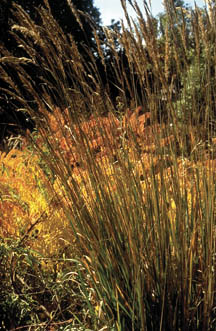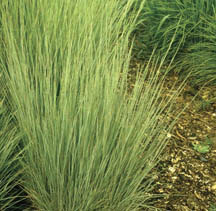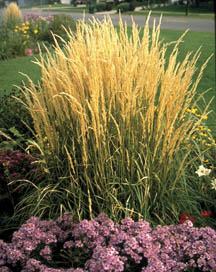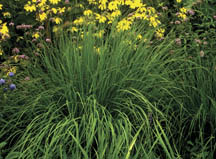by C.R. Wilson* (10/11)
Quick Facts…
- Grasses are adaptable and can grow in poorer soils better than many other garden plants.
- Grasses require little effort to maintain.
- Grasses come in many heights, colors, textures and have varying water requirements.
- Grass seed heads and foliage add fall and winter interest.
- Dried grasses have many decorative uses indoors and out.
- Grasses can be used as groundcovers, specimen plants, for erosion control, and as vertical design elements.
The term ornamental grass is used to include not only true grasses Gramineae) but close relatives such as sedges (Cyperaceae), rushes (Juncaceae), hardy bamboos (particularly the genus Phyllostachys), and others. This fact sheet presents ornamental grasses adapted to the Rocky Mountain region. Listings are for USDA hardiness zones 5, 4 and 3. Some popular, tender grasses grown as annuals also are listed.
Native American Grasses for Drier Sites
Grasses are useful in different types of landscapes ranging from formal gardens to native, plains and meadows. Native grasses add a sense of place to Colorado gardens. Settlers moving from east to west found a succession of different grass species. Examining this succession and the differences in climate and soils teaches gardeners about the cultural requirements of native grasses.
 |
Figure 1: Indian grass (Sorghastrum nutans). |
In the eastern part of the Midwest, also known as the Corn Belt, grows the tall grass prairie. The grass in this area can reach the height of a person or more. The soil is highly organic, the climate is more humid, and the soil moisture is more consistent. Dominant grasses include big bluestem (Andropogon gerardii), switch grass (Panicum virgatum), and Indian grass (Sorghastrum nutans). Rainfall in this region averages 25 to 30 inches or more.
West of the Corn Belt in the present day Wheat Belt lies the transitional mixed grass prairie between tall and short grasses. Rainfall is less in many years and the subsoil is permanently dry, limiting grass height to 2 to 4 feet. Grasses include little bluestem (Schizachyrium scoparium), Western wheatgrass (Agropyron smithii), June grass (Koeleria macrantha syn. K. cristata) and needle grass (Stipa spartea). These grasses are mixed with species from the adjoining tall and short grass prairies depending on the soils, year and the rainfall that ranges from an average of 18 to 24 inches.
 |
Figure 2: Little bluestem (Schizachyrium scoparium). |
 |
Figure 3: Karl Foerster’s feather reed
|
 |
Figure 4: Prairie dropseed (Sporobolus heterolepis). |
The Front Range and Eastern Plains of Colorado are part of the short grass prairie that lies in the rain shadow of the Rocky Mountains. This is a high and dry steppe climate dominated by short grasses of inches in height that include buffalo grass (Buchloe dactyloides) and blue grama (Bouteloua gracilis), the state grass of Colorado. The area is semiarid and the average annual rainfall is 10 to 15 inches.
Gardeners growing native gardens should understand the differences in rainfall where these grasses are native and plan supplemental irrigation accordingly. Generally among the natives, the taller the grass, the more water the plant requires.
Grasses for Moderately Moist to Moist Gardens
Grasses from many parts of the world are commonly used in American gardens. Many of these are from the moist climates of Asia and Europe and must be amply watered. Some natives such as switch grass (Panicum virgatum) also require regular irrigation in Colorado’s semiarid climate.
Among the most widely used Asian grass introductions are the Maiden grasses (Miscanthus species) and their many varieties. Some, such as variegated Japanese silver grass, have been grown in America for a century and are still very popular. Miscanthus are noted for their silky flower tassels that persist into winter. New varieties have been bred for flowers that emerge well above the foliage, earlier flowering, and plants that don’t fall over. One of the newer varieties, ‘Morning Light’ is rapidly gaining in popularity.
Newer varieties of other grasses continue to be introduced. An example is ‘Northern Lights’ tufted hairgrass (Deschampsia cespitosa), a non-flowering variety with cream white and pink variegated leaves.
Feather reed grass (Calamagrostis x acutiflora ‘Karl Foerster’) has a wheat-like look that makes it one of the showiest and most popular grasses. It grows in upright clumps lending a vertical accent. The straight, greenish flower spikes form in May to June, turn golden, then bleach tan and persist into the winter.
Grasses in this group notable for their shade tolerance include Northern sea oats (Chasmanthium latifolium), tufted hair grass (Deschampsia cespitosa) and Korean feather reed grass (Calamagrostis brachytricha).
Design and Care
Grasses add variety to many types of gardens, including water, Japanese, rock, wildlife, craft, xeriscape, container and others. Ornamental grasses add two elements to the garden experience that are not readily obtained from many other plants: movement and sound. Grasses look well against a dark background and placed to catch morning or evening light.
Grasses add a significant vertical presence to the winter landscape and are commonly left standing until spring. the dried foliage of ornamental grasses is combustible during the winter and is likely best removed in public and commercial sites.
Some grasses grow best under warm temperatures (warm season) and others in cooler temperatures (cool season). Plant ornamental grasses in the spring. Container-grown grasses can be planted all season, stopping a month before first frost. Late planting of grass divisions is not recommended, particularly for warm season types.
Grasses generally grow best in three to five hours of direct sun each day. In shade, these grasses may not bloom, are often lax and tend to fall over, and may not develop peak fall color.
Most grasses can benefit from mulching and many from cutting back, usually just before new growth begins in the spring. Use hedge shears and wear gloves to prevent cuts from the razor-sharp edges of some species.
A number of perennial grasses form root masses that can be very difficult to divide and transplant. Most annual types can easily be grown from seed.
Few pests bother grasses. If aphids or mites appear, spray with a strong stream of water to control the problem.
| Table 1: Ornamental grasses for dry conditions. Note: Native refers to grasses native to the Midwest, Colorado and the Southwestern United States. | |||
| Name | Hardiness zone and season |
Height (ft.) | Comments |
|---|---|---|---|
| Achnatherum hymenoides (syn. Oryzopsis hymenoides) Indian rice grass ‘Nezpar’ – greater cold hardiness |
3 – cool | 1.5 – 2 | Narrow, medium-green leaves form tufted clumps. Airy flower panicles on wiry stems. Native that grows well in sands and well-drained soils. Turns dormant with summer heat. Shade intolerant. Fresh and dried flowers. To 8,000 ft. |
| Andropogon gerardii Big bluestem |
4 – warm | 3 – 6 | Native with blue green foliage in a stiff, upright clump. Fall blooming. Three-branched seed heads resemble bird’s feet. Orange fall color. Tolerates clay but best in sandy soil. Prefers moisture, will withstand drier soils. Shade intolerant. To 7,500 ft. |
| Bouteloua curtipendula Side oats grama |
4 – warm | 1 – 2.5 | Native prairie grass noted for one-sided seed head arrangement. Gray-textured foliage in clumps. Heavy or sandy soil. To 9,000 ft. |
| Bouteloua gracilis Blue grama |
3 – warm | 1 – 1.5 | A clump-forming, hardy, native grass. Use in unirrigated areas and with wildflowers. All soils. Shade intolerant. To 9,500 ft. |
| Eragrostis trichodes Sand love grass |
5 – cool | 1 – 2 | Medium green foliage in small clumps. Pink flowers turn golden on 3-foot stalks from mid- to late summer. A native, not for clay or poorly drained soil. Shade intolerant. To 6,500 ft. |
| Festuca arizonica Arizona fescue |
3 – cool | 1 – 1.5 | Native, fine-textured grass with blue-green leaves. Best in clay soils. Provide some supplemental water. To 10,000 ft. |
| Festuca cinerea, F. glauca Blue fescue ‘Boulder Blue’- compact, very blue and heavy bloomer ‘Elijah Blue’ – powder blue variety ‘Sea Urchin’ – compact tufted shape |
4 – cool | 0.5 – 1.5 | Small, blue to bright green clumps with tan to gold-toned seed-heads. Many varieties. Provide some supplemental water. Sun to partial shade. Excellent for sands and not for heavy, wet soils. Divide often to renew. Evergreen in zone 5. Introduced from central Europe. Species hardy to 10,000 ft. |
| Festuca idahoensis Idaho fescue ‘Siskiyou Blue’ – spruce blue |
5 – cool | 1.5 | Native. the thin leaves are longer than F. ovina lending a soft look. Light shade, all soil types. To 11,000 ft. |
| Helictotrichon sempervirens Blue oat grass |
4 – cool | 2.5 | Dense, blue, pointed leaves in mostly upright, tufted clumps. One-sided seed heads in June begin white then turn golden. Sun to light shade. Semi-evergreen. From central Europe. To 9,000 ft. |
| Koeleria macrantha (syn. K. cristata) June grass |
4 – cool | 1 | A small, green, native clump grass with showy, white flower panicles in June. A host for butterfly larvae. Interplant with wildflowers. Shade tolerant and also shows wide soil tolerance. To 11,000 ft. |
| Nassella tenuissima Silky threadgrass |
5 – cool | 1.5 | Erect clumps of fine textured, yellow-green leaves. Silky seed heads backlight well and form waves in mass plantings. Also useful in containers and for dried flowers. Becomes dormant in hot, dry weather. Tolerates light shade. Reseeds. Native to New Mexico and Texas. To 6,000 ft. |
| Schizachyrium scoparium Little bluestem ‘Blaze’-pink-orange to red-purple fall color ‘Cimmaron’ – blue foliage ‘the Blues’ – bright blue with purple to burgundy fall color |
3 – warm | 2 – 3 | Green to blue-green to blue clumps. Fluffy, white seed plumes. Orange to red fall color. Native best grown in clay soils. Tolerates light shade. Drought tolerant. To 7,500 ft. See figure 2. |
| Sorghastrum nutans Indian grass ‘Bluebird’ – blue-gray foliage ‘Holt’ – early bloom, fall color ‘Sioux Blue’ – blue foliage |
4 – warm | 3 – 5 | Tall grass prairie native. Foliage color varies, turns yellow then orange in fall. Tan-yellow seed heads. Shade intolerant. Prefers moisture, will withstand drier soils. To 6,500 ft. See figure 1. |
| Sporobolus heterolepis Prairie dropseed |
4 – warm | 3 | thin, fine-textured, emerald leaves, gold to orange-red in fall. A native accent plant. Provide some moisture. Tolerates light shade. Seeds attract birds. See figure 4. |
| Table 2: Ornamental grasses for moderately moist to moist gardens. |
|||
| Name | Hardiness zone and season |
Height (ft.) | Comments |
|---|---|---|---|
| Arrhenatherum elatius bulbosum ‘Variegatum’ Variegated bulbous oat grass |
4 – cool | 0.5 – 1 | White-striped tufts of foliage. Oat-like flower spikes in May-June. Grow in partial shade and moist conditions. |
|
Calamagrostis x acutiflora |
4 – cool | 2 – 3 | Showy, upright, arching clump. Medium green, stiff foliage. Orange to yellow fall color. Flower spikes persist into winter. Tolerates heavy soils. Medium dry to moist conditions. ‘Karl Foerster’ blooms earlier and is more useful in short growing season areas than C. arundinacea. See figure 3. |
| Calamagrostis brachytricha (Stipa brachytricha) Korean feather reed grass |
4 | 3 | Tolerates partial shade. Provide adequate moisture. Tall, feathery pinkish-gray flower heads. |
| Carex grayi Gray’s or morning star sedge |
4 | 2 – 2.5 | Light green leaves in clumps. Noted for clusters of 1-inch fruits resembling spiked maces. Prefers moist conditions. Native. |
| Carex morrowii Japanese sedge |
5 | 1 | Semi evergreen, arching clumps with bright green or variegated foliage. Provide constant moisture, light shade, well-drained soils. |
| Carex muskingumensis Palm sedge |
4 | 2 | Slowly spreading with palm-like foliage that yellows in full sun. Requires shade and moist conditions. |
| Chasmanthium latifolium Northern sea oats |
5 – cool | 2 | Noted for its showy, drooping flowers and light green, upright, bamboo-like foliage. Flat green flowers start green, turn copper. Blooms well in shade. Reseeds. |
| Deschampsia caespitosa Tufted hair grass ‘Northern Lights’ – pink, white and gold variegated foliage, non-blooming |
4 – cool | 3 – 4 | Dark green, tufted foliage. Airy flower panicles change from green to yellow to near purple. All soils except unamended, heavy clay. Requires some supplemental moisture and grows in light shade. To 12,000 ft. |
| Holcus lanatus Velvet grass |
5 – cool | 1 | Soft, gray-green foliage with white flower panicles in midsummer. Provide moisture, partial shade and well-drained soil. |
| Leymus arenarius (Elymus arenarius) Blue lyme grass |
4 – cool | 2 – 3 | Blue foliage in mounded clumps turns yellow in fall. Quite invasive in loose soils. Seed heads not notable. |
| Miscanthus ‘Giganteus’ (M. floridulus) Giant silver grass |
4 – warm | 8 | Giant arching form with 10 inch, fluffy silver flowers. Does not bloom every year in Colorado. Provide ample moisture. |
| Miscanthus oligostachys Small Japanese silver grass |
4 – warm | 3 – 4 | Short, wide leaves have a bamboo look. Early flowers, arching form. More useful than maiden grass in small scale landscapes. |
| Miscanthus sacchariflorus Silver banner grass |
3 – warm | 6 | Large grass useful in colder climates. Less desirable than giant silver grass in warmer zones. |
| Miscanthus ‘Purpurascens’ – Flame grass |
4 | 5 | Flowers open pale pink then turn silver, tolerates light shade, reliable orange-red fall color. |
| Miscanthus sinensis Maiden or silver grass ‘Gracillimus’ – silver leaf midribs, fine texture and copper-colored flowers ‘Morning Light’ – white leaf margins, red flowers turn cream, tolerant of light shade ‘Nippon’ – compact, fine texture, red- bronze fall color ‘Silberfeder’ – vase shape and leaves with silver midrib ‘Strictus’ – porcupine grass has stiff leaves with yellow bands ‘Variegatus’ – white-striped leaves, shade tolerant ‘Yaku Jima’ – compact 3-4 feet, copper flowers, red fall color ‘Zebrinus’ – white leaf bands |
4b-5 – warm
4 |
5 – 6 | Widely used grass for variable leaf color, arching form and persistent, whisk-like flowers. One of the most – and longest-used grasses in American gardens. Many varieties are available varying in leaf color, size and texture. Watch for new varieties with outstanding ornamental characteristics for testing in your garden. |
| Molina caerulea ssp. arundinacea Moor grass ‘Heidebraut’ – compact (4 ft.) ‘Moorhexe’ – compact with purple flowers ‘Skyracer’ – tall ‘Windspiel’ – gold flowers |
4 – warm | 7 | Light green, arching foliage turns yellow in fall. Brown, yellow or purple flowers fade to tan. Full sun. Grow in moist soil that is not extremely alkaline. Mature leaves and flowers break at the base minimizing winter interest. See figure 6. |
| Panicum virgatum Switch grass ‘Heavy Metal’ – blue foliage ‘Prairie Sky’ – sky-blue foliage |
4b – warm | 4 – 5 | Stiff, upright clumps with showy, airy flowers of pink, red or silver in midsummer. Tolerates soil extremes. Good cut flower. Native. Yellow fall color. To 7,500 ft. |
| Pennisetum alopecuroides Fountain grass ‘Hameln’ – compact, 2 ft ‘Little Bunny’ – 1.5 ft. ‘Moudry’ – brown-black flowers |
5 – warm | 3 | Bright green foliage, bottlebrush flowers. Some varieties freeze out in coldest winters. |
| Phalaris arundinacea ‘Feeseys’ Ribbon grass |
4 – warm | 2 – 3 | Pink-white leaves with green stripes. Enclose to keep it from spreading. Blooms decorative, requires moisture. |
| Saccharum ravennae Plume grass | 5 – warm | 4 | Fluffy, cream-colored flowers on 8-ft. stalks in August. Northern substitute for tender pampas grass, Cortaderia selloana. |
| Sesleria autumnalis Autumn moorgrass |
4b-5 – cool | 1.5 | Olive green foliage in tufted mounds. Narrow, purplish flower spikes persists through winter. |
| Table 3: Annual grasses. | |||
| Name |
Hardiness zone
and season |
Height (ft.)
|
Comments |
|---|---|---|---|
| Cortaderia selloana ‘Pumila’ Dwarf pampas grass |
6 – warm
|
3
|
Dwarf and more cold hardy version of tender pampas grass that may be semi-perennial once established in the very warmest parts of Zone 5. Fluffy white flower heads. (Saccharum ravennae, plume grass, is recommended as a reliable perennial substitute.) |
| Cymbopogon citratus Lemon grass |
Annual
|
2
|
Useful for citrus aroma and as a cooking herb. Grow in pots and bring indoors at the first sign of frost. |
| Melinus nerviglumis Ruby grass ‘Pink Crystals’ |
Annual
|
1 – 2
|
Blue-green foliage with ruby pink blooms in early summer that eventually turn white. Best in a warm location in full sun. Good for fresh and dried arrangements. See figure 5. |
| Pennisetum setaceum ‘Rubrum’ Tender fountain grass |
Annual
|
2 – 3
|
the red variety of this annual grass is widely sold for use in containers and annual flower beds. |
| Pennisetum villosum Feather top |
Annual
|
2
|
Silky, rabbit tail-like flowers emerge green turn creamy white. Bright green leaves. |
| Pennisetum glaucum ‘Purple Majesty’ – Purple Majesty millet |
Annual
|
4
|
the burgundy-purple leaves and bottlebrush flower stalks make this a standout in beds and containers. Good cut flower. |
*C.R. Wilson, Colorado State University Extension horticulture agent, Denver County. Special acknowledgements to Green Industry members, H. McMillan, K. Grummons and S. Yetter for their input on this publication. Revised 11/04. Revised 10/11.
Go to top of this page.





